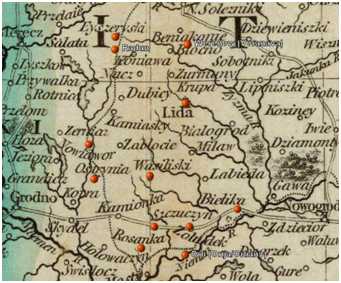 |
|
| Contents | |
| Lida Uezd Homepage | |
| Lida Uezd History | |
| Lida Uezd Towns | |
| Lida Uezd Maps |
|
| Searchable
Databases |
|
| Lida Uezd
during the Holocaust |
|
| JewishGen
Home Page |
|
| KehilaLinks
Home Page |
|
|
|
compiled from the sources below by Ellen Sadove Renck Żyrmuny, Zyrmuny/Zhirmuny/Zhrmuny
at 54º01' 25º13'
and
the dependent villages of Bastuny, Berezna, Bielewicze,
Bieniejki, Biernucie, Bilance, Bojary, Budrewicze, Dajnow, Dajnowka,
Dworzyszcze, Ejtuny, Gieretance, Gierwieniki, Gudy,
Marjampol/Mariampole/Mariampol' at 54º31 25º19,
Miguny[?Maguny at 54º02 25º08 ?], Osowa, Powilance,
Pozyzma, and Wiekance Zyrmuny is a village and center of local rural government in Voronovo district, sixteen kilometers from Voronovo, and eight kilometers from the railway station at Bastuny, on the road: Lida-Vilnius. 1993 population: 670 people, 270 houses. First mentioned in the Chronicles in the fifteenth century: In the beginning of fifteenth century, Zhyrmuny belonged to the Butrim family. Close to 1437, merchant Voiteh Kuchuk established a Catholic church. At the end of the fifteenth century to the beginning of the sixteenth century, Zhyrmuny belonged to the Mantovtavich family. In 1513 Duke Yuri Radzivil owned it. On the 1613 map of Makovski, Zyrmuny was called as mestechko in Lida povet. In the seventeenth century, it belonged to the Zavisha family. In 1624, Yan Zavisha established a new catholic church that burnt at the time of a war in the middle of the seventeenth century. The church was rebuilt in 1673. In the beginning of the eighteenth century, it again belonged to Radzivil. In 1724, Avgust II gave Magdeburg Rights to Zyrmuny. In the second half of the eighteenth century, there was a school and a hospital. In 1777, there were thirty-one houses. In 1788, Carolina Radzivil established a Catholic church (Church of Saint Cross) that still exists. In 1795, the Russian Empire controlled the town. In 1860 there were 29 houses, 271 people were living there, Catholic church, a prayer house, hospital, school, synagogue and a post office. In the nineteenth century and the beginning of the twentieth century, Zyrmuny was a volostj center in Lida povet of Vilna guberniya and belonged to Tyshkevich and Shvanebah. In the beginning of the twentieth century, there were 323 people and a public technical school. Beginning 1921, Zyrmuny belonged to Poland as a miasteczko (small town) and gmina wiejska (parish village) of the First Uchastok, Lida povet of Novogrudok voevodstvo. The Justice of the Peace was in Lida and the Justice Court in Wilno. The 1928 population was 373. The railway was eight kilometers away in Bastuny. The post office and telephone were in Zyrmuny with the telegraph in Lida. The town had one Catholic church, mills, sawmills, and a pitch factory. Beginning 1939, Zyrmuny belonged to the BSSR. On October 12, 1940, it became a rural government center in Radun district. June 1941-July 1944, the Nazis occupied it. Beginning April 3, 1959, Zyrmuny belonged to Voronovo district. In 1971, there were 587 people and 198 houses. There are a research agricultural station, a mill, a public service workshop, forestry, a secondary school, a music school, a kindergarten, a cafe, a post office and two shops. There is a monument to Heroes of World War II. It is a birthplace of architect K. Padchashinski (1790-1860). Sources: If
you have Lida uezd
materials to share, please considering donating it.
If you read Yiddish or Hebrew, please contact us.
Records are
held both in Grodno and Vilna archives.For Lida records translation,
your tax deductible contribution by credit card via the secure server
at either group or by mail will grow our knowledge. For a $100
donation, you receive all these records translated two years ahead of
their posting on JewishGen. Every penny collected is used for Lida uezd
projects only. Records include censuses; family lists; marriages,
births, death records; prenumeraten lists; and more. Please contact Judy Baston
with any questions.For current translations, please see the ALD:
All Lithuanian Database and Belarus
SIG Database.
|
